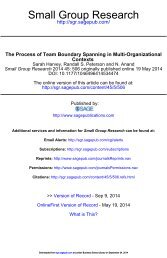A Dynamic Perspective on Diverse Teams: Moving From The Dual Process Model to A Dynamic Coordination-Based Model of Diverse Team Performance - Kannan Srikanth, Sarah Harvey & Randall Peterson
The existing literature on diverse teams suggests that diversity is both helpful to teams in making more information available and encouraging creativity and damaging to teams in reducing cohesion and information sharing. Thus the extant literature suggests that diversity within teams is a double-edged sword that leads to both positive and negative effects simultaneously.
The existing literature on diverse teams suggests that diversity is both helpful to teams in making more information available and encouraging creativity and
damaging to teams in reducing cohesion and information sharing. Thus the
extant literature suggests that diversity within teams is a double-edged sword
that leads to both positive and negative effects simultaneously.
Create successful ePaper yourself
Turn your PDF publications into a flip-book with our unique Google optimized e-Paper software.
A <str<strong>on</strong>g>Dynamic</str<strong>on</strong>g> <str<strong>on</strong>g>Perspective</str<strong>on</strong>g> <strong>on</strong> <strong>Diverse</strong> <strong><strong>Team</strong>s</strong> † 35<br />
Berdhal, Aneeta Rattan, and the seminar audience at Singapore Management<br />
University for helpful comments. <strong>Kannan</strong> <strong>Srikanth</strong> acknowledges generous<br />
support from the Strategic Organizati<strong>on</strong> Design Unit at the University <strong>of</strong><br />
Southern Denmark. All errors remain our own.<br />
Downloaded by [L<strong>on</strong>d<strong>on</strong> Business School Library], [<strong>Randall</strong> Peters<strong>on</strong>] at 06:11 31 January 2016<br />
References<br />
Anc<strong>on</strong>a, D. G., Okhuysen, G. A., & Perlow, L. A. (2001). Taking time <strong>to</strong> integrate temporal<br />
research. Academy <strong>of</strong> Management Review, 26, 512–529.<br />
Anteby, M., & Anders<strong>on</strong>, C. ∗ (2014). <strong>The</strong> shifting landscape <strong>of</strong> LGBT organizati<strong>on</strong>al<br />
research. Research in Organizati<strong>on</strong>al Behavior, 34, 3–25.<br />
Armstr<strong>on</strong>g, D. J., & Cole, P. (2002). Managing distances and differences in geographically<br />
distributed work groups. In P. Hinds & S. Kiesler (Eds.), Distributed work<br />
(pp. 167–187). Cambridge, MA: MIT Press.<br />
Arrow, H., McGrath, J. E., & Berdahl, J. L. (2000). Small groups as complex systems:<br />
Formati<strong>on</strong>, coordinati<strong>on</strong>, development, and adaptati<strong>on</strong>. Thousand Oaks, CA: Sage.<br />
Bantel, K., & Jacks<strong>on</strong>, S. (1989). Top management and innovati<strong>on</strong>s in banking: Does the<br />
compositi<strong>on</strong> <strong>of</strong> the team make a difference? Strategic Management Journal, 10,<br />
107–124.<br />
Behfar, K. J., Peters<strong>on</strong>, R. S., Mannix, E. A., & Trochim, W. M. K. (2008). <strong>The</strong> critical<br />
role <strong>of</strong> c<strong>on</strong>flict resoluti<strong>on</strong> in teams: A close look at the links between c<strong>on</strong>flict<br />
type, c<strong>on</strong>flict management strategies, and team outcomes. Journal <strong>of</strong> Applied<br />
Psychology, 93, 170–188.<br />
Bezrukova, K., Jehn, K. A., Zanut<strong>to</strong>, E. L., & Thatcher, S. M. (2009). Do workgroup faultlines<br />
help or hurt? A moderated model <strong>of</strong> faultlines, team identificati<strong>on</strong>, and<br />
group performance. Organizati<strong>on</strong> Science, 20(1), 35–50.<br />
Bobo, L. D., Charles, C. Z., Krysan, M., & Simm<strong>on</strong>s, A. D. (2012). <strong>The</strong> real record <strong>on</strong><br />
racial attitudes. In P. V. Marsden (Ed.), Social trends in American life: Findings<br />
from the general social survey since 1972 (pp. 28–83). Princet<strong>on</strong>, NJ: Princet<strong>on</strong><br />
University Press.<br />
Bodenhausen, G. V., Kang, S. K., & Peery, D. (2012). Social categorizati<strong>on</strong> and the percepti<strong>on</strong><br />
<strong>of</strong> social groups. In S. T. Fiske & C. N. Macrae (Eds.), <strong>The</strong> Sage handbook<br />
<strong>of</strong> social cogniti<strong>on</strong> (pp. 318–336). L<strong>on</strong>d<strong>on</strong>: Sage Publicati<strong>on</strong>s.<br />
Bunders<strong>on</strong>, J. S., & Sutcliffe, K. M. (2002). Comparing alternative c<strong>on</strong>ceptualizati<strong>on</strong>s <strong>of</strong><br />
functi<strong>on</strong>al diversity in management teams: <strong>Process</strong> and performance effects.<br />
Academy <strong>of</strong> Management Journal, 45, 875–893.<br />
Camerer, C. (2003). Behavioural game theory. Princet<strong>on</strong>, NJ: Princet<strong>on</strong> University<br />
Press.<br />
Chatman, J., & Flynn, F. (2001). <strong>The</strong> influence <strong>of</strong> demographic heterogeneity <strong>on</strong> the<br />
emergence and c<strong>on</strong>sequences <strong>of</strong> cooperative norms in work teams. Academy <strong>of</strong><br />
Management Journal, 44, 956–974.<br />
Chatman, J. A. (2010). Norms in mixed sex and mixed race work groups. <strong>The</strong> Academy<br />
<strong>of</strong> Management Annals, 4, 447–484.<br />
Chatman, J. A., Polzer, J. T., Barsade, S. G., & Neale, M. A. (1998). Being different yet<br />
feeling similar: <strong>The</strong> influence <strong>of</strong> demographic compositi<strong>on</strong> and organizati<strong>on</strong>al<br />
culture <strong>on</strong> work processes and outcomes. Administrative Science Quarterly, 43,<br />
749–781.
















